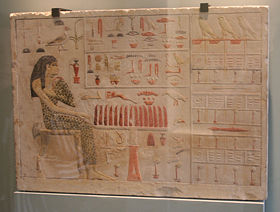
Nefertiabet
Encyclopedia
Nefertiabet was an ancient Egypt
ian princess of the 4th dynasty
. She was possibly a daughter of Pharaoh Khufu
.
A statue of her, now in Munich, probably originates from her tomb. She is best known from her beautiful slab stela
, now in the Louvre
. Nefertiabet is shown seated facing to right. She is depicted with a long wig and a panther skin garment. Her right hand is extended to table. A table in front of her is piled with bread. Under the table offerings are depicted including linen and ointment on the left, and on the right offerings of bread, beer, oryx, and bull. On the right of the slab a linen list is depicted.
The tomb originally contained one shaft which contained the burial of Nefertiabet. The shaft contains a passage and a chamber. Fragments of a white limestone coffin with a flat lid were found. A canopic pit had been dug in one of the corners of the chamber. The chamber contained some bowls and jars. An annex with one additional burial shaft was added later, but was completely plundered.

Ancient Egypt
Ancient Egypt was an ancient civilization of Northeastern Africa, concentrated along the lower reaches of the Nile River in what is now the modern country of Egypt. Egyptian civilization coalesced around 3150 BC with the political unification of Upper and Lower Egypt under the first pharaoh...
ian princess of the 4th dynasty
Fourth dynasty of Egypt
The fourth dynasty of ancient Egypt is characterized as a "golden age" of the Old Kingdom. Dynasty IV lasted from ca. 2613 to 2494 BC...
. She was possibly a daughter of Pharaoh Khufu
Khufu
Khufu , also known as Cheops or, in Manetho, Suphis , was a Pharaoh of Ancient Egypt's Old Kingdom. He reigned from around 2589 to 2566 BC. Khufu was the second pharaoh of the Fourth Dynasty. He is generally accepted as being the builder of the Great Pyramid of Giza, one of the Seven Wonders of...
.
Tomb
Her tomb at Giza is known (G 1225). The mastaba is about 24.25 x 11.05 m. in size.A statue of her, now in Munich, probably originates from her tomb. She is best known from her beautiful slab stela
Slab stela
The slab stela was an original form of the steles of ancient Egypt, but in a horizontal dimension. Some of the earliest ones from mid- to late-3rd millennium BC were painted Slab Steles...
, now in the Louvre
Louvre
The Musée du Louvre – in English, the Louvre Museum or simply the Louvre – is one of the world's largest museums, the most visited art museum in the world and a historic monument. A central landmark of Paris, it is located on the Right Bank of the Seine in the 1st arrondissement...
. Nefertiabet is shown seated facing to right. She is depicted with a long wig and a panther skin garment. Her right hand is extended to table. A table in front of her is piled with bread. Under the table offerings are depicted including linen and ointment on the left, and on the right offerings of bread, beer, oryx, and bull. On the right of the slab a linen list is depicted.
The tomb originally contained one shaft which contained the burial of Nefertiabet. The shaft contains a passage and a chamber. Fragments of a white limestone coffin with a flat lid were found. A canopic pit had been dug in one of the corners of the chamber. The chamber contained some bowls and jars. An annex with one additional burial shaft was added later, but was completely plundered.


